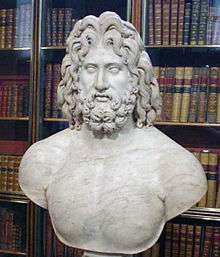Long hair
.jpg)

Long hair is a hairstyle where the head hair is allowed to grow to a considerable length. Exactly what constitutes long hair can change from culture to culture, or even within cultures. For example, a woman with chin-length hair in some cultures may be said to have short hair, while a man with the same length of hair in some of the same cultures would be said to have long hair.
Males having short, cut hair are in many cultures viewed as being under society's control, such as while in the military or prison or as punishment for a crime. Long lustrous female hair is generally rated attractive by both men and women across cultures.[1][2] The prevalence of trichophilia (hair partialism or fetishism) is 7% in the population, and very long hair is a common subject of devotion in this group.[3][4]
Biological significance
.jpg)
Humans, horses, orangutans and lions are among the few species that may grow their head hair or manes very long. Humans are believed to have lost their fur 2.5–3 million years ago as hominids when transitioning from a forest habitat to the open savanna, as an effect of natural selection, since this development made it possible to run fast and hunt animals close to the equator without getting overheated. An exception was however head hair, which was kept to provide thermal insulation of the scalp from the sun, to protect against ultra-violet radiation exposure, and also to provide cooling (when sweat evaporates from soaked hair). The ability to grow straight hair, has been observed among Homo sapiens sub-groups in less sunny regions further away from the equator. Relative to kinked Afro-textured hair, straight hair allows more UV light to pass to the scalp (which is essential for the production of vitamin D, that is important for bone development).
Scientists also view the ability to grow very long hair as a result of sexual selection, since long and healthy hair is a sign of fertility and youth.[5] An evolutionary biology explanation for this attraction is that hair length and quality can act as a cue to youth and health, signifying a woman's reproductive potential.[6] As hair grows slowly, long hair may reveal 2–3 years of a person's health status, nutrition, age and reproductive fitness. Malnutrition and deficiencies in minerals and vitamins due to starvation causes loss of hair or changes in hair color (e.g. dark hair turning reddish).[7]
Psychological significance
Anthropologists speculate that the functional significance of long head hair may be adornment, a by-product of secondary natural selection once other androgenic/somatic hair (body hair) had largely been lost. Another possibility is that long head hair is a result of Fisherian runaway sexual selection, where long lustrous hair is a visible marker for a healthy individual. For some groups or individuals, however, short hair is the selected trait.[5]
By seven to nine months, infants can tell the sexes apart based on hair length, voice pitch and faces.[8]
Cultural meaning
Ways of life often viewed as more rigid, such as soldiers and religious cultures, frequently have explicit rules regarding hair length. For example, Buddhist monks shave their heads as part of their order of worship.[9] Similarly, religious men with long hair include the Nazarites of the Hebrew Bible (Samson being a famous example)[10] and the Sikhs.[11] Subservient cultures may view male long hair negatively, and are sometimes detected by their rulers through hair length, as was the case with the Gaelic Irish under English rule and the Moors under Spanish rule in Medieval Spain.
East Asian cultures have traditionally associated unkempt hair in a woman with irresponsible attitude, as women in East Asia were expected to tie up their hair in styles such as the ponytail, plait, or any bun, as a symbol of responsibility.[12]
Transferred meaning
The traditional connotation of "long hair" in English meant, roughly, someone artistically knowledgeable or wise, an aesthete.[13] As a descriptive term, it has been applied to Merovingians and classical music enthusiasts, as well as hippies and aesthetes.[13]
Hair lengths
 An American woman with armpit length hair |
 A Fillipina woman with mid back length hair |
 A Nepalese woman with waist length hair |
 An Italian woman with hip/tailbone length hair |
 A Sri Lankan woman with classic length hair |
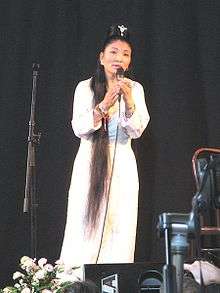 A Tibetan woman with knee length hair |
Hair length is most often measured (in centimeters or inches) from the line of the scalp on the forehead up over the highest point of the skull to its termination, and sometimes from the crown, the latter resulting in 10 centimeter lower values in average.[14] In cosmetology, hair lengths are usually categorized according to the part of the body where the bulk of the longest hair terminates: chin level, shoulder length, lower shoulderblade/mid-back level, waist length, hip-length, classic length (extends to almost buttock-length, i.e. upper thigh-length, where the legs meet the buttocks), thigh-length, knee-length and ankle/floor length hair.[14][15]
Hair usually takes about two years to reach shoulder length,[16] and about seven years to reach waist-length/hip-length, including occasional trims (approximately 80–90 cm (32–36 inches) from forehead for most people) [15][16]
Maximum hair length
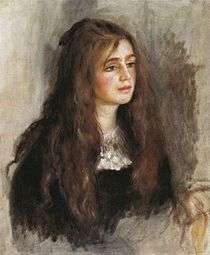
The maximum hair length that is possible to reach is about 15 cm (6 in) for infants (below the age of 1), about 60 cm (24 in) for children, and generally 100 cm (40 in) for adults. Documentation for decrease of the maximum length with age cannot be found in the literature. Some individuals can reach excessive lengths. Lengths greater than 150 cm (59 in) are frequently observed in long hair contests.[17] Xie Qiuping had the longest documented hair in the world, measuring 5.627 m (18 ft 5.54 in) in May 2004.[18]
The maximum terminal hair length depends on the length of the anagen (period of hair growth) for the individual. Waist-length hair or longer is only possible to reach for people with long anagen. The anagen lasts between 2 and 7 years, for some individuals even longer, and is followed by shorter catagen (transition) and telogen (resting) periods. At any given time, about 85% of hair strands are in anagen.[19] The fibroblast growth factor 5 (FGF5) gene affects the hair cycle in mammals including humans; blocking FGF5 in the human scalp (by applying a herbal extract that blocked FGF5) extends the hair cycle, resulting in less hair fall and increased hair growth.[20]
Cultural history
Europe
Ancient Greece and Rome
In ancient Greece, long male hair was a symbol of wealth and power, while a shaven head was appropriate for a slave. The ancient Greeks had several gods and heroes who wore their hair long, including Zeus, Achilles, Apollo, and Poseidon. Greek soldiers are said to have worn their hair long in battle. Such warriors considered it a sign of aristocracy and are said to have combed it openly in order to show off. Also, in order to keep enemies from getting a hold of it in battle, they were known to cut the front short, but leave it long in the back, where it was more out of reach (mullet). A widely held alternative interpretation of the conventional belief is that they kept it long, and simply tied it back in a style known as a ponytail in order to keep it out of their enemies' reach. The ponytail method allowed warriors, who often traveled to battle with a minimal amount of equipment in order to avoid excessively heavy loads over long marches, to keep their hair manageable with a small piece of string to hold their pony tail in place and a knife to cut the back to length with one simple slice. Around the sixth century, however, the Greek men shifted to shorter hairstyles, with the exception of the Spartans. Women in the culture remained with the longer style, which for them showed freedom, health, and wealth, as well as good behavior.[21] In men, it was considered a sign of false pride by this time.[22]
Pliny the Elder in his Natural History and Varro related that the Romans did not begin to cut their hair short until barbers were introduced to Italy from Sicily by P. Ticinius Mena in 299 BC.[23] Women in Roman times valued long hair, usually with a center part. Apart from in the earliest times, men's hair was usually shorter than women's, although other cultures of the time, such as Greeks in the east, considered long hair to be typical of philosophers, who were thought to be too engrossed in learning to bother with hair.[24] Strictly in the province of Rome, however, the shorter hairstyle was especially popular.[22] When Julius Caesar conquered the Gauls, who favored long hair, he ordered it to be cut short.[25]
Middle Ages
In the European middle ages, shorter hair often signified servitude and peasantry, while long hair was often attributed to freemen, as was the case with the Germanic Goths and Merovingians.
The Gaelic Irish (both men and women)[26] took great pride in their long hair—for example, a person could be heavily fined for cutting a man's hair short against his will.[27] When the Anglo-Normans and the English colonized Ireland, hair length came to signify one's allegiance. Irishmen who cut their hair short were deemed to be forsaking their Irish heritage. Likewise, English colonists who wore their hair long in the back were deemed to be forsaking their role as English subjects and giving in to the Irish life. Thus, hair length was one of the most common ways of judging a true Englishman in this period. Muslims in Christian areas were ordered to keep their hair short and parted, as their longer style was considered rebellious and barbaric.[28]
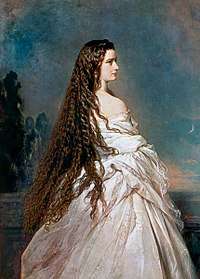
The long hair tradition was widespread among English and French men in the 11th and 12th centuries, though it was considered, mostly because of endorsement of the Roman Catholic Church, acceptable for men also to have shorter hair. The tradition was largely brought about by monarchs who rejected the shorter hairstyle, causing the people to follow. Wulfstan, a religious leader, worried that those with longer hair would fight like women, and be unable to protect England from foreign invasion. This idea can be found in later military leaders as well, such as those of the American Confederacy.[29] Knights and rulers would also sometimes cut or pull out their hair in order to show penitence and mourning, and a squire's hair was generally shorter than a knight's. Married women who let their hair flow out in public were frowned upon, as this was normally reserved for the unwed, although they were allowed to let it out in mourning, to show their distressed state. Through these centuries it was expected of Eastern Christians to wear long hair as well as long beards, which was especially expected from clergy and monks.
In England, during the English Civil Wars of 1642 to 1651, male hair length was emblematic of the disputes between Cavaliers and Roundheads (Puritans). Cavaliers wore longer hair, and were less religious-minded, thought of by the Roundheads as lecherous. The more devout Roundheads typically had somewhat shorter hair[9]
Around this time, long hair in England also came to be associated with adventurers who traveled to America and were familiar with the native culture there, short hair with less adventurous types.
Trends among women in 20th and 21st centuries
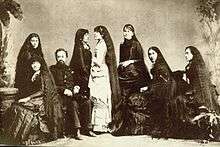 The Seven Sutherland Sisters were singing and showing off their famous floor-length hair in a sideshow of Barnum & Bailey's from about 1882 to 1907. |
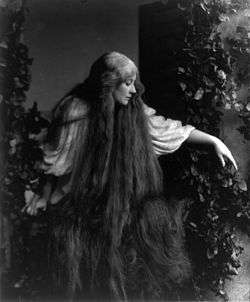 Opera singer Mary Garden in 1908 with knee-length hair |
 Indonesian woman with waist-length hair |
Dutch woman with thigh-length hair |
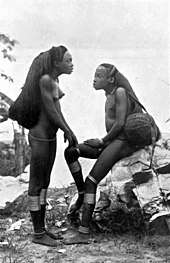 Ngbandi girls with hip-length hair |
Growing and wearing long hair was common among women in the Western world until World War One.[15] Long female hair never ceased in western culture, though it was rare during the 1920s and 1930s.
In most current cultures, it is more typical for women to wear long hair than for men to do so. An American study shows significant correlation between hair length and age, which indicates that younger women tend to have longer hair than older women. A significant correlation was also found between women's hair length and hair quality. Moreover, hair quality was correlated with the women's perceived physical health. Consistent with principles of evolutionary psychology, these results indicate that hair length and quality can act as a cue to a woman's youth and health, signifying reproductive potential. The correlation between the woman's hair length and marital status, or number of children, was however not more than to be expected from the correlation between hair length and age.[6]
Trends among men in 20th and 21st centuries
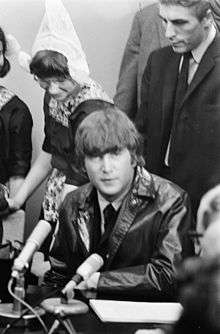
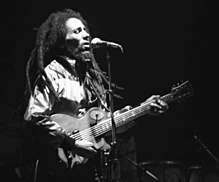
Before World War One men generally had longer hair and beards. However, short hair on men was introduced in World War One for soldiers. Slaves and defeated armies were often required to shave their heads. The trench warfare in 1914 to 1918 exposed men to flea and lice infestations, which prompted the order to cut short hair, establishing a military tradition.[15]
Beat poets during the 1950s wore longer hairstyles. By 1960, a small "beatnik" community in Newquay, Cornwall, England (including a young Wizz Jones) had attracted the attention of their neighbors for growing their hair to a length past the shoulders, resulting in a television interview with Alan Whicker on BBC television's Tonight series.[30] The 1960s also introduced The Beatles, who started a more widespread longer hair trend. The social revolution of the 1960s led to a renaissance of unchecked hair growth,[15] and long hair, especially on men, was worn as a political or countercultural symbol or protest and as a symbol of masculinity. This cultural symbol extended to several Western countries in the Americas, Western Europe, South Africa, and Australia.[31] Specific long hairstyles such as dreadlocks have been part of counterculture movements seeking to define other alternative cultures and lifestyles since this time.[12] Longer hair in general remained popular due to the youth rebellion throughout the liberal decade of the 1960s.[31] The long hair trend grew with the spread of the hippie movement in the 1960s[31] and, in the 1970s, longer hair styles would become the norm among men and women.
In the 1970s, the popularity of Jamaica's reggae music and musician Bob Marley prompted interest in dreadlocks internationally. The anti-establishment philosophy of Rastafari, echoed in much of the reggae of the time, resonated with left-leaning youth of all ethnicities – especially and primarily among African Americans and other Blacks, but among counterculture Whites as well.[32] Eastern Christians are encouraged to wear long hair with long beard. In the 1980s the view of long hair as a solitary signifier of political or counter-cultural identity was countered and parodied in films such as Rambo and many other militaristic heroes of media which challenged then-contemporary views of tradition.[33] In the 2000s longer hairstyles among men became popular among neopagans and rock enthusiasts;[34] for example, musicians in Metal bands and their fans often wear long hair. Long hair may be grown for the purpose of being donated to an organization, such as Locks of Love, for hairpieces to help those who could not have hair otherwise, such as those who are diagnosed with alopecia aerate. Today long hair has gained even more popularity. Even among mainstream men it is socially acceptable to have hair reaching around the upper back. This could in part be due to the "man bun" trend where men pull their shoulder length or longer hair back into a topknot bun.
Americas
Native Americans
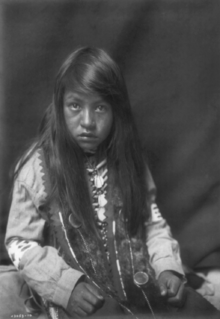
Many Native American men wore long hair before the arrival of western influences on their culture. (In Cherokee legends, for example, males said to be handsome were often described as having "long hair almost to the ground" or similar formulas.[35]). Both men and women of these cultures have frequently struggled to maintain their tradition but have faced heavy opposition. Many consider it a sign of giving in to western influences to have their hair cut.[36][37] Early American settlers saw long-haired, native men as rebelling against their civilized society. Mountain men and trappers who adopted the customs were also considered amoral, and often identified by their long hair.[38] Since the cultural movements of the Sixties and Seventies, however, Native Americans have felt less pressure to have short hair, as different movements have defended their cultural rights.[39] For example, several states have loosened prison regulations, allowing Native Americans to wear long hair during incarceration, along with other cultural allowances.[40] There has been resistance to these changes, however, as long hair is sometimes used to hide drugs, as well as to identify with a gang.[41]
African Americans
When African slaves were freed in America, they struggled to reach the social status of whites. Many former slaves tried to conform their hairstyles as part of this struggle. Women, especially, felt pressure to make their hair straight, rather than keeping the tightly coiled style they had known.[42] However, during the civil rights movement of the 1950s and 1960s, African-Americans such as Malcolm X advocated hairstyles such as afros and dreadlocks, in order to embrace their race, and to return to West African roots.[43]
Social pressures at the time were heavily influencing these Americans (women) to have, straight hair, like white people did.[44] This resulted in the Black is beautiful movement, wherein African Americans wore their long natural hair, that was however, untreated and unmodified. More recently, hair-extensions have become widespread. Scholars have pointed out the continued pressure on black women to have straight smooth hair. Amelia Jones points out that dolls for children, such as Barbies, add to this pressure, citing as an example a new, black Barbie with straight hair. Blacks, she believes, should be able to be themselves without feeling pressured to "tame" their hair.[45]
Contemporary North America
|
"She, as a veil down to the slender waist, |
| – John Milton's description of Eve in Paradise Lost |
1972, it was estimated that 24% of American women wore shoulder length hair or longer (44% of women in ages 14 to 44), meaning slightly more than 12% of men and women altogether. Similar frequency was found in 2001, when it was estimated that about 13% of the US adult population, male as well as females, has hair shoulder-length or longer, about 2.4% have hair reaching to the bottom of the shoulder blades or longer, about 0.3% have hair waist length or longer, and only about 0.017% have hair buttocks-length or longer.[46] By extrapolating the above data and the number of hair length records, the number of people with shoulder-length hair or longer in the USA is estimated to be 27 million, those with waist-length hair roughly 900,000, those with buttocks-length hair to be 40,000, with knee length hair to 2,000 and with ankle length hair to 70.[14]
Africa

Throughout much of Africa, afro-textured hair is the most frequent hair form, except among the Afro-Asiatic (Hamito-Semitic) speaking populations in North Africa and the Horn of Africa. In the latter regions, naturally long hair is instead more common.[47]
In West African cultures, women with long hair were highly valued. Long, thick hair was seen as a sign of health, strength, and capability to bear many children. In keeping with this general theme, women who were too young for marriage would shave a portion of their heads to signal so. This tradition, however, did not extend to every West African culture, as several valued shorter hair.[48]
Asia
Historically, East Asian cultures viewed long hair as a sign of youth and aesthetic beauty. Long hair is associated with private life and sexuality. East Asian cultures see long, unkempt hair in a woman as a sign of sexual intent or a recent sexual encounter, as usually their hair is tied up.[12] Lay Buddhists have long hair, while Buddhist monks have shaved heads.[9]
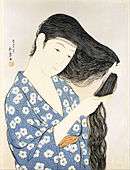 Japanese woman combing her long hair. (Colour woodblock print from 1920 by Hashiguchi Goyō.) |
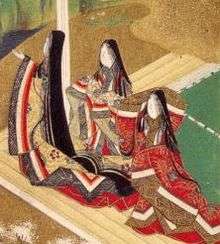 Illustration of The Tale of Genji, painted by Tosa Mitsuoki (1617–1691). |
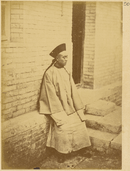 Chinese orthodox Christian man from 1874 |
 Nosu girls in China 1922. |
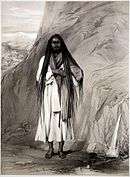 |
Judaism
_-_A_Yemenite_Habani_family_celebrating_Passover.jpg)
In the Old Testament, the Nazirites would go for long periods of time without cutting their hair to show devotion to God.[49] Samson is one example; his strength depended upon his refraining from cutting his hair, described as worn in "seven locks".[10]
In the New Testament, Saint Paul (formerly Saul of Tarsus) wrote, "Doth not even nature itself teach you, that, if a man have long hair, it is a shame unto him? But if a woman have long hair, it is a glory to her: for her hair is given her for a covering. But if any seem contentious, we have no such custom, neither do the churches of God."[50]
Strict orthodox Judaism forbids men from cutting their sidelocks, but other hair may be kept as desired. Hair is not cut during a time of mourning. The Torah in Deuteronomy 14:1 prohibits removing hair in mourning for the dead.
Islam
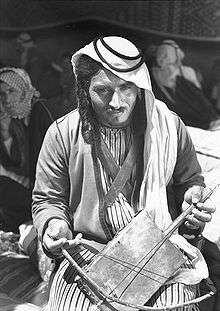
In the Muslim world, it seems the trend of hair styles is now favouring short over long in men. In the past, Bedouin Muslims often wore their hair in long braids, but influences from the Western world have caused a change in attitudes. Bedouins are now less likely to have long hair.[51] Islamic countries in North Africa such as Egypt view long hair in men as modernist and in one case the Egyptian police viewed it as Satanic and a sign of an infidel.[52] Spanish rulers during the Medieval Period suspected long-haired males to be Moors or Moriscos, therefore long hair was forbidden since it was believed to be a Moorish custom. However, modern North African men have adopted Western short hair.
Muslims regard the Prophet Muhammad as the best example to live by, and try to emulate him whenever possible. The Islamic Prophet Muhammad reportedly in Sahih Muslim had hair that "hung over his shoulders and earlobes".[53] Sahih Bukhari, regarded the most authentic of hadith, also supports this using a prime example of the prophet Isa (Jesus).[54] The Prophet Muhammad has also described Jesus as "having long hair reaching his ear lobes."[55] Malik's Muwatta 51.2.6 reported, Yahya related to me from Malik from Yahya ibn Said that Abu Qatada al-Ansari said to the Messenger of Allah, may Allah bless him and grant him peace, "I have a lot of hair which comes down to my shoulders, shall I comb it? The Messenger of Allah. may Allah bless him and grant him peace, said, "Yes, and honour it." Sometimes Abu Qatada oiled it twice in one day because the Messenger of Allah, may Allah bless him and grant him peace, said to him. "Honour it."
With regards to women, neither Qur'an nor Sunnah explicitly state that women cannot cut their hair. Hadith does mention that women should not imitate men, and vice versa, and hence many scholars on this assumption, decree that women should let their hair grow longer than the hair of the Prophet, reaching beyond their shoulders, as hadith mentions that the Prophet had his hair between his shoulder and his earlobes. (He described Jesus's hair, which hung to his earlobes, as long.[56])
However, according to some hadiths regarding the rules of awrah, women are required to grow hair long, long enough that it would cover the breasts or as much awrah parts of the body when they're being buried, because she lacks clothes and long hair would be used as a covering instead.
Some Muslims are also opposed to men having long hair as it is also important in Islam to have clear differences (in appearance) between sexes. And generally these cultures encourage women to have long hair and men to have short hair.[57] The Taliban in Afghanistan viewed long hair for men as a western influence, and punished it by arrest and forced haircuts,[58] although this would be a direct contradiction of the sunnah of the Prophet. Similar measures have been taken by Islamists in Iraq.[59] In spite of this, several Taliban affiliated members of the Mehsud clan are recognisable by their long hair.[60][61] The Saudi Islamist fighter Amir Khattab was also notable for his long hair. Dervishes of some Sufi orders, such as the Kasnazani, often have long hair and whirl it around during rituals.[62]
China
In ancient China and Korea, hair was regarded as a precious legacy from parents. Most people would never cut their hair after they became adults, and cutting off one's hair was a penalty for minor crimes. Both men and women would coil up their hair and many hair-coiling styles were developed.
Beginning in 1619, the ethnic Manchu Qing dynasty forced all men in China to adopt the queue: a long braid down the back with the hair near the forehead completely shaved. Hair length and style became a life-or-death matter in 1645 as the Manchu told them either their hair or their head would be cut. Nearly every Han rebel group began by shearing this pigtail (most especially in the case of the Taiping, who were known in Chinese as the "Longhairs"), but the queue on penalty of death lasted until 1911, when the Chinese people cut their queues in unison at a time of rebellion. Americans at first judged Chinese immigrant laborers to be poor workers because their long hair brought an association with women.[63]
Islamic and Christian missionaries among the Chinese were strong advocates of shorter male hair for their converts.[64] Around the Destruction of Four Olds period in 1964, almost anything seen as part of Traditional Chinese culture would lead to problems with the Communist Red Guards. Items that attracted dangerous attention if caught in the public included jewelry and long male hair.[65] These things were regarded as symbols of bourgeois lifestyle, that represented wealth. People had to avoid them or suffer serious consequences such as tortures and beatings by the guards.[65] More recently, long hair was ridiculed in China from October 1983 to December 1983, as part of the short and unsuccessful Anti-Spiritual Pollution Campaign.[66]
Also, in Chinese ancient and modern poetry, long hair is a common symbol used by poets, for example Li Bai and Li Shangyin, to express their depression and sadness.
Southeast Asia
In Southeast Asia and Indonesia, male long hair was valued in until the seventeenth century, when the area adopted outside influences including Islam and Christianity. Invading cultures enforced shorter hairstyles on men as a sign of servitude, as well. They were also confused at the short hairstyles among women in certain areas, such as Thailand, and struggled to explain why women in the area had such short hair. They came up with several mythical stories, one of which involved a king who found a long hair in his rice and, in a rage, demanded that all women keep their hair short.[64]
In rural areas in certain Asian countries, for example India, girls still usually let their hair grow long, and knee-length hair is not unusual.[67]
Japan
In the medieval Japan, heian gentleman were not very interested in a woman's physical beauty and rarely had an opportunity to see it. The only physical attribute of interest was a woman's hair, which had to be thick and longer than she was tall. The fascination with long hair was one reason why a woman's becoming a nun was regarded with such seriousness — it could never again grow to its full length. This explains why Genji refuses to let Murasaki (his de facto wife in the classical Japanese novel The Tale of Genji) take the tonsure when she is ill.[68]
Sikhism
For Sikhs, Kesh is the practice of allowing one's hair to grow naturally as a symbol of devotion to God and lack of worldliness.[11]
The Sikhs were commanded by Guru Gobind Singh at the Baisakhi Amrit Sanchar in 1699 to wear long uncut hair called Kesh at all times to signify the strength and vitality of the Sikh people. This was one of the 'five requisites of faith', collectively called Kakars that form the external visible identifiers to clearly affirm a Sikh's commitment and dedication to the order (Hukam) of the tenth master and made one a member of the Khalsa. The Khalsa is the "Saint-Soldier" of Guru Gobind Singh who stated the following: "He does not recognize anyone else except One Lord, not even the bestowal of charities, performance of merciful acts, austerities and restraint on pilgrim-stations; the perfect light of the Lord illuminates his heart, then consider him as the immaculate Khalsa." (Guru Gobind Singh in the Dasam Granth page 1350)
The Kesh or unshorn long hair is an indispensable part of the human body as created by waheguru that is the mainstay of the 'Jivan Jaach' and the Rehni that was prescribed by Guru Gobind Singh Sahib by which a Sikh is clearly and quickly identified, Kesh. The kanga, another requisite of faith is usually tucked behind the "Rishi Knot" and tied under the turban. The uncut long head hair and the beard in the case of men forms the main kakar for the Sikhs.
KESADHARI, a term defining a Sikh as one who carries on his head the full growth of his kes (hair) which he never trims or cuts for any reason. Anyone, Sikh or non-Sikh, may keep the hair unshorn, but for the Sikh kes, unshorn hair, is a requisite of faith and an inviolable vow. The Sikh Rahit Maryada published by the Shiromani Gurdwara Prabandhak Committee, statutory body for the control and management of Sikh shrines and by extension for laying down rules about Sikh beliefs and practices, issued in 1945, after long and minute deliberations among Sikh scholars and theologians, defines a Sikh thus: Every Sikh who has been admitted to the rites of amrit, i.e. who has been initiated as a Sikh, must allow his hair to grow to its full length. This also applies to those born of Sikh families but [who] have not yet received the rites of amrit of the tenth master, Guru Gobind Singh. ".
See also
- Grooming
- Haircut
- Hair extensions
- Hair stick
- Lady Godiva
- Long hair fetishism, a form of Trichophilia
- Rapunzel
Images
- Female long hair in art (Gallery at Wikimedia commons)
- Female long hair photos (Gallery at Wikimedia commons)
- Male long hair in art (Gallery at Wikimedia commons)
- Male long hair photos (Gallery at Wikimedia commons)
References
- ↑ Buss, David M. (2005). The handbook of evolutionary psychology. John Wiley and Sons. p. 309. ISBN 978-0-471-26403-3.
- ↑ Bereczkei, T. (2007). "Hair length, facial attractiveness, personality attribution; A multiple fitness model of hairdressing". Review of Psychology. 13 (1): 35–42.
- ↑ Scorolli, C; Ghirlanda, S; Enquist, M; Zattoni, S; Jannini, E A (2007). "Relative prevalence of different fetishes". International Journal of Impotence Research. 19 (4): 432–7. doi:10.1038/sj.ijir.3901547. PMID 17304204.
- ↑ "Heels top the global fetish leader board". England.
- 1 2 Watson, James (2005). Darwin: the Indelible Stamp; the Evolution of an Idea. Philadelphia: Running Press. p. 1042. ISBN 0-7624-2136-3.
- 1 2 Hinsz, Verlin B.; Matz, David C.; Patience, Rebecca A. (2001). "Does women's hair signal reproductive potential?". Journal of Experimental Social Psychology. 37 (2): 166. doi:10.1006/jesp.2000.1450.
- ↑ Sugiyama, Lawrence S. (2005) "Physical Attractiveness in Adaptationist Perspective", Chapter 10 in Buss, David M. (ed.) The Handbook of Evolutionary Psychology. John Wiley & Sons, Inc. ISBN 978-0-471-26403-3
- ↑ Williams, Simon Johnson; Birke, Lynda I. A.; Bendelow, Gillian (2003). Debating biology: sociological reflections on health, medicine, and society. Routledge. p. 130. ISBN 0-415-27903-8.
- 1 2 3 Leach, E. R. (July 1958). "Magical Hair". Journal of the Royal Anthropological Institute. 88 (2): 147–164. doi:10.2307/2844249. JSTOR 2844249.
- 1 2 Judges 13–16
- 1 2 Fowler, Jeaneane (1997). World Religions: an Introduction for Students. Brighton: Sussex Academic Press. p. 352. ISBN 1-898723-48-6.
- 1 2 3 Maynard, Margaret (2004), Dress and Globalisation, Manchester: Manchester University Press, p. 104, ISBN 0-7190-6389-2
- 1 2 Oxford English Dictionary
- 1 2 3 Clarence Robbins and Marjorie Gene Robbins, "Scalp hair length. II. Estimating the percentages of adults in the USA and larger populations by hari length." Journal of cosmetic science 54.4 (2003): 367–378.
- 1 2 3 4 5 Gonzalez, Anthony (2007). Cosmetology. Global Media. p. 54. ISBN 81-89940-45-7.
- 1 2 Hemat, R. A. S. (2007). Andropathy. Urotext. p. 375. ISBN 1-903737-08-7.
- ↑ Robbins, Clarence R. (2002). Chemical and physical behavior of human hair. Springer. ISBN 0-387-95094-X.
- ↑ Guinness World Records: Longest hair. guinnessworldrecords.com
- ↑ Tortora & Derrickson (2012). Principles of Anatomy & Physiology (13 ed.). John Wiley & Sons, Inc. p. 163.
- ↑ Maeda, T.; Yamamoto, T.; Isikawa, Y.; Itoh, N.; Arase, S. (2007). "Sanguisorba Officinalis Root Extract Has FGF-5 Inhibitory Activity and Reduces Hair Loss by Causing Prolongation of the Anagen Period". Nishi Nihon Hifuka. 69: 81. doi:10.2336/nishinihonhifu.69.81.
- ↑ Irwin, M. Eleanor (Oct 1990). "Odysseus' "Hyacinthine Hair" in 'Odyssey' 6.231". Phoenix. 44 (3): 205–218. doi:10.2307/1088933. JSTOR 1088933.
- 1 2 Nicolson, Frank W. (1891). "Greek and Roman Barbers". Harvard Studies in Classical Philology. 2: 41–56. JSTOR 310326.
- ↑ Pliny the Elder at Perseus
- ↑ Bartman, Elizabeth (Jan 2001). "Hair and the Artifice of Roman Female Adornment". American Journal of Archaeology. 105 (1): 1–25. JSTOR 507324.
- ↑ Felt, Joseph (1967). Customs of New England. New York: Burt Franklin. p. 187. ISBN 0-8337-1105-9.
- ↑ Connolly, Sean J (2007). "Prologue". Contested island: Ireland 1460–1630. Oxford University Press. p. 7.
- ↑ The Brehon Laws: A Legal Handbook: Chapter VII, Laurence Ginnell (1894)
- ↑ Bartlett, Robert (1994). "Symbolic Meanings of Hair in the Middle Ages". Transactions of the Royal Historical Society. Sixth series. 4: 43–60. doi:10.2307/3679214. JSTOR 3679214.
- ↑ McManus, Howard Rollins (1989). The Battle of Cloids Mountain of Virginia, 1864. University of Michigan. p. 35.
- ↑ Whicker, Alan. Tonight: "Beatniks in Newquay". BBC, 1960.
- 1 2 3 Bronski, Michael (2000), The Pleasure Principle: Sex, Backlash, and the Struggle for Gay Freedom, Stonewall Inn Editions, pp. 95–96, ISBN 0-312-25287-0
- ↑ Gossai, Hemchand; Murrell, Nathaniel (2000), Religion, Culture, and Tradition in the Caribbean, New York: St. Martin's Press, pp. 181–190, ISBN 0-312-23242-X
- ↑ Lu, Hsiao-Peng (1997), Transnational Chinese Cinemas, Honolulu: University of Hawaii Press, p. 229, ISBN 0-8248-1845-8
- ↑ Weinstein, Deena (2000), Heavy Metal, New York: Da Capo Press, p. 129, ISBN 0-306-80970-2
- ↑ Kirk, Lowell (1999). "Cherokee Myths and Legends". Retrieved 2007-09-09.
- ↑ Ferris, Jeri (1991), Native American Doctor, Minneapolis: Carolrhoda Books, pp. 32–33, ISBN 0-87614-443-1
- ↑ Kilcup, Karen (2000), Native American Women's Writing, C. 1800–1924, Cambridge: Blackwell Publishers, pp. 314–316, ISBN 0-631-20518-7
- ↑ Cavallo, Dominick (1999), A Fiction of the past, New York: St. Martin's Press, p. 90, ISBN 0-312-23501-1
- ↑ Nagel, Joane (1997), American Indian Ethnic Renewal, Oxford Oxfordshire: Oxford University Press, p. 191, ISBN 0-19-512063-9
- ↑ French, Laurence (2003), Native American Justice, Lanham: Rowman & Littlefield Publishers, Inc, pp. 113–117, ISBN 0-8304-1575-0
- ↑ Fontana, Vincent (2003), Municipal Liability, Aspen Law & Business Publishers, pp. 241–242, ISBN 0-7355-1375-9
- ↑ Byrd, pp. 25–49
- ↑ Synnott, Anthony (September 1987). "Shame and Glory: A Sociology of Hair". The British Journal of Sociology. 38 (3): 381–413. doi:10.2307/590695. JSTOR 590695.
- ↑ Taylor, Paul C. (1999). "Malcolm's Conk and Danto's Colors; Or, Four Logical Petitions concerning Race, Beauty, and Aesthetics". The Journal of Aesthetics and Art Criticism. 57 (1): 16–20. doi:10.2307/432060. JSTOR 432060.
- ↑ Jones, Amelia (2003). The Feminism and Visual Culture Reader. New York: Routledge. p. 343. ISBN 0415267056
- ↑ Robbins, C; Robbins, M. G. (2003). "Scalp hair length. I. Hair length in Florida theme parks: An approximation of hair length in the United States of America". Journal of cosmetic science. 54 (1): 53–62. PMID 12644859.
- ↑ Hiernaux, Jean (1975). The People of Africa. Scribners. p. 59. ISBN 0684140403.
- ↑ Byrd, pp. 2–5
- ↑ Numbers 6:5, Numbers 6:18–19
- ↑ KJV 1 Corinthians 11:14–16
- ↑ Massad, Joseph (2001), Colonial Effects, New York: Columbia University Press, pp. 137–140, 208–210, ISBN 0-231-12322-1
- ↑ Heper, Metin (1998), Ismet Inonu: the Making of a Turkish Statesman, Boston: Brill Academic Publishers, p. 153, ISBN 90-04-09919-0
- ↑ Sahih Muslim Book 30 Number 5773: "Qatada reported: I asked Anas b. Malik: How was the hair of Allah's Messenger? Thereupon he said: His hair was neither very curly nor very straight, and they hung over his shoulders and earlobes."
- ↑ Sahih Al-Bukhari Volume 7 Book 72 Number 788: "Narrated Al-Bara': I did not see anybody in a red cloak looking more handsome than the Prophet Narrated Malik: The hair of the Prophet used to hang near his shoulders. Narrated Shu'ba: The hair of the Prophet used to hang down to the earlobes."
- ↑ Sahih Al-Bukhari Volume 9 Book 87 Number 128 : Narrated 'Abdullah bin 'Umar: Allah's Apostle said, "I saw myself (in a dream) near the Ka'ba last night, and I saw a man with whitish red complexion, the best you may see amongst men of that complexion having long hair reaching his earlobes which was the best hair of its sort, and he had combed his hair and water was dropping from it, and he was performing the Tawaf around the Ka'ba while he was leaning on two men or on the shoulders of two men. I asked, 'Who is this man?' Somebody replied, '(He is) Messiah, son of Mary.' Then I saw another man with very curly hair, blind in the right eye which looked like a protruding out grape. I asked, 'Who is this?' Somebody replied, '(He is) Messiah, Ad-Dajjal.'"
- ↑ Sahih Al-Bukhari Volume 9 Book 87 Number 128
- ↑ Joseph, Suad; Najmabadi, Afsaneh (2005), Encyclopedia of Women & Islamic Cultures: Family, Body, Sexuality and Health, Volume 3, Boston: Brill Academic Publishers, p. 35, ISBN 90-04-12819-0
- ↑ Rashid, Ahmed (2002), Taliban: Islam, oil and the new great game in central Asia, I B Tauris & Co Ltd, p. 219, ISBN 1-86064-830-4
- ↑ Raghavan, Sudarsan (2006-10-06), "Another freedom cut short: Iraq's barbers under threat", The Washington Post, archived from the original on 2006-10-06
- ↑ "South Asia | Profile: Abdullah Mehsud". BBC News. 2007-07-24. Retrieved 2013-10-27.
- ↑ "Taliban leader Hakimullah Mehsud threatens US months after 'death'". The Daily Telegraph. 2010-05-03. Retrieved 2013-10-27.
- ↑ Wong, Edward (2005-08-22). "Iraq's Sufis attacked as strife widens". The New York Times.
- ↑ Prasso, Sheridan (2005), The Asian Mystique, New York: Public Affairs Press, pp. 115–116, ISBN 1-58648-214-9
- 1 2 Reid, Anthony (1988). Southeast Asia in the Age of Commerce, 1450–1680. New Haven: Yale University Press. p. 82. ISBN 0-300-04750-9.
- 1 2 Law, Kam-yee (2003), The Chinese Cultural Revolution Reconsidered: beyond purge and Holocaust, Palgrave Macmillan, ISBN 0-333-73835-7
- ↑ "Olympic crackdown on China's bad habits". BBC News. August 6, 2007. Retrieved 2007-09-09.
- ↑ Sherrow, Victoria (2006) Encyclopedia of hair: a cultural history, Greenwood Publishing Group. p. 242. ISBN 0313331456
- ↑ The Tale of Genji, a novel about courtly life in medieval Japan.
Bibliography
- Byrd, Ayana; Tharps, Lori (2002). Hair Story. New York: St. Martin's Griffin. ISBN 0-312-28322-9.
